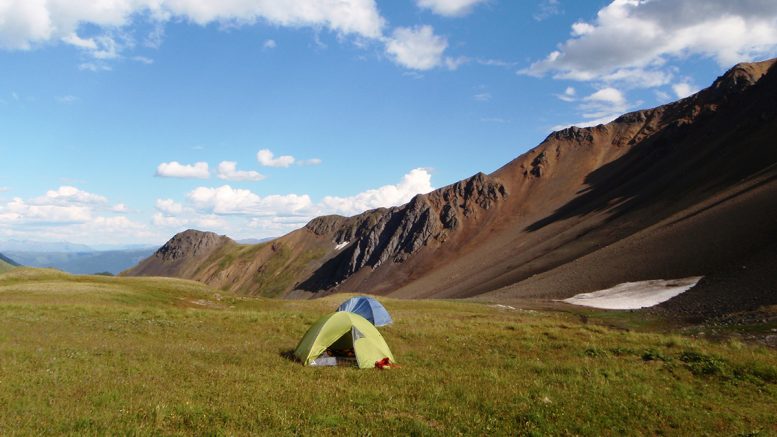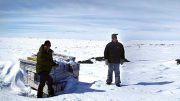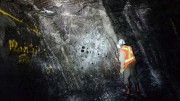VANCOUVER — A new era of exploration in northwestern British Columbia’s historic Golden Triangle region hasn’t yet resulted in much greenfield discovery, but Vancouver-based GT Gold (TSXV: GTT; US-OTC: GTGDF) hopes its Tatogga gold project can change that narrative.
The company’s founders privately funded a target-generation work at the property over the past few years, leading to a maiden drill program due to begin soon. GT Gold completed its qualifying transaction, alongside a $2.5-million private placement, in mid-2016.
The 310 sq. km project lies on the Klastline plateau 14 km west of Imperial Metals’ (TSX: III) Red Chris copper-gold mine, and less than 1 km west of the town of Iskut. GT Gold’s wholly owned subsidiary, New Chris Minerals, acquired Tatogga in 2011, and then completed an airborne magnetic survey and collected 1,800 geochemical soil samples.
“The regional surveying we did privately through 2013 to 2014 unearthed quite the compelling gold-in-soil anomaly across a substantial area,” GT Gold president and CEO Kevin Keough says during an interview.

The Tatogga high camp roughly 14 km due west of Imperial Metals‘ (TSX: III) Red Chris copper-gold mine. Credit: GT Gold.
“We were pretty excited, but the industry was really struggling at that time. It was tough to raise any money, so we waited until market conditions improved to go public. Last July we pulled the trigger, and the initial financing came together quickly after that.”
GT Gold’s focus so far has been the greenfield Saddle gold prospect, which has two sub-parallel, west- to northwest-trending anomalies.
Saddle South takes its name from a “saddle-shaped” upland ridge and tableland of residual soils, with little outcrop.
The company reports that the limited outcrop feature “generally subtle” veining and alteration, while high surface metal values on its western edge correspond with “locally rusty-weathering, quartz-sericite-pyrite altered volcanic host rocks.”

Topographic shot of the Saddle target areas. Credit: GT Gold.
Saddle North sits 200 metres topographically lower, and it appears to be covered to a “considerable degree” by glacial deposits.
“We’re pretty confident the soil anomalies reflect an in-situ source. There are glaciers next to our project area, but we don’t believe our ground has been disturbed too much,” Keough says.
“We’ve tentatively put our finger on apparent structures that run through the area, which is where we’ll focus our drilling. There’s not a lot to see at surface, but downslope next to our anomaly we have sampled high grades in at least one structure, and there are volcanics and instrusives at Saddle South,” he adds.
The Saddle South anomaly runs 1.5 km in an east–west direction and contains an “irregular core” of gold-in-soil values, as defined by contoured values exceeding 0.5 gram gold per tonne.
GT Gold caught market attention in late 2016, when it reported 58 soil samples returned an average value of 7.45 grams gold at the target, while median soil assays fell between 1.61 and 1.80 grams gold.
Mineralization at Saddle is not yet well understood, though there are indications it is associated with post-deformation, malachite-chalcopyrite bearing quartz-carbonate veins that are oriented parallel to regional, dominant-shearing directions.

The Saddle gold ridge. Credit: GT Gold.
GT Gold’s geologists have reportedly found “completely quartz-sericite-pyrite altered rock with numerous outcrops of gossanous material” with material gold and copper values.
In March the company outlined a plan to a first drill program at Saddle South that would include 98 reverse-circulation (RC) and diamond core holes over 4,600 metres. GT Gold intends to drill 76 RC holes across 2,000 metres to improve targeting before mobilizing the diamond rig.
It will also complete 20 line km of induced-polarization (IP) geophysics and another 1,200 soil samples.

JoAnne Nelson, senior geologist and northern B.C. manager with the B.C. Geological Survey, inspects rocks at GT Gold’s Saddle gold project in British Columbia. Credit: GT Gold.
“We’ll get a really good response from IP since there are clearly sulphides associated with the gold, and we think it’s prudent to start the program with RC,” Keough says, noting that X-ray fluorescence will also be used in the field.
“We’ll rely on a little track to transport the rig, so it’s almost being leveraged as a prospecting tool. We need to quickly figure out the most prospective targets, so we’re using the ground-based geophysics, along with the RC program, to really help us understand the strike and depth potential,” he adds.
The company closed a $3.2-million private placement in April, wherein it issued 2.7 million hard shares priced at 32¢ each, and 5.2 million flow-through shares at 45¢ each. The net proceeds provide GT Gold with working capital of nearly $5 million, and support plans for a second phase of diamond-core drilling that may “double the total metres this year.”
“We’ll certainly aim to get as much done as we can, but it can be a pretty narrow field season up there,” Keough says. “Our story has generated excitement in the market because it’s something completely fresh, which is rather unusual these days. It didn’t have a single historical soil or rock sample on the entire target area. So it’s early days for us, but we’re optimistic that we’re seeing the upper levels of a system.”
GT Gold shares have closed at a 52-week high of 38.5¢ per share at press time. There are nearly 64 million shares outstanding for a $24.5-million market capitalization.






Be the first to comment on "GT Gold to drill Tatogga in BC’s Golden Triangle"